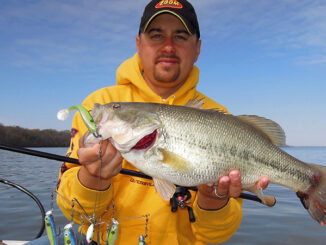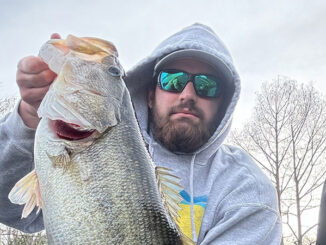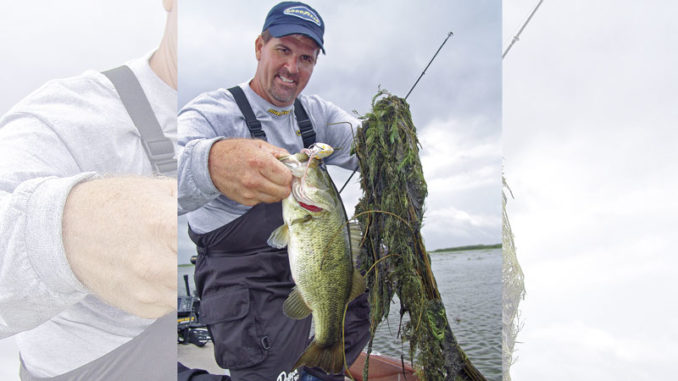
Not all bass chase shad up a creek in the fall; big grass mats will yield big bites.
Bass don’t need a calendar to know winter’s coming.
Shorter days and sliding water temperatures tell them it’s belly packing time and, while a great many will move up from summer depths to chase shad back in the creeks, another game offers fall action that’s as good as — and dare we say maybe even a little better than — the creek routine.
We’re talking about main-lake grass beds, especially the ones not far from a major channel. Some scenarios find these vegetation resorts simply a stopover for schools of baitfish headed for backwater haunts, but in other cases, these dense gardens of hydrilla, milfoil and coontail will harbor baitfish and the bass that seek them all the way up until the onset of winter.
Greg Hackney
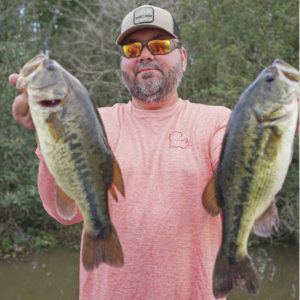
Greg Hackney, a bass pro based in Gonzales, La., pointed out that the concept applies to bass meccas like Toledo Bend, the Red River, Atchafalaya Basin and just about any waterway with healthy fall grass. When autumn spurs shad to move shallower — usually when the water temperature hits about 70 degrees — many of those baitfish will stop on the big grass beds that have been filling in with vegetation all summer and forego any further movement into creeks.
For bass eager to pack on weight for the approaching cold season, this creates a food-rich scenario. For anglers, it means a bass-rich environment that’s easy to pinpoint.
“Those bigger fish are hard to target when they don’t set up on anything, when they’re just running around chasing shad,” Hackney said. “But when they set up on that grass, you can figure out a target, right where that fish is sitting.”
J.T. Kenney
J.T. Kenney, a retired bass pro now serving as a commentator on Major League Fishing’s television shows, is also a fan of fall grass fishing, if for no other reason than the big-bite potential.
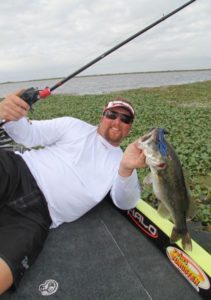
“I really believe that you still have the opportunity to catch a big fish,” Kenney said. “I know a lot of fish follow the bait back into the creeks, but I don’t think the 6-, 7-, 8-, 9-pounders do. In the fall, it’s harder to catch a big fish; everybody knows that. I just think if you can find some main-lake grass fish, you have a better opportunity to luck into catching a 7-pounder.
“Not that you can’t catch a 7-pounder in a creek; I just think you have a better chance of doing that on main-lake grass. I just don’t think the big fish are as apt to migrate long distances.”
Hackney puts it like this: “You can go back in the creeks and catch 2-pounders, but you can get out here and fish grass and catch 5-pounders.”
Coming to the edge
While fish inhabiting deeper, main-lake structure will pull up and head to the creeks, canals and bays to feed up on shad, bream, crawfish and whatever they can catch, those that pass the summer in dense grass mats make similar migrations. Only difference is that the grass fish have shorter strolls — just to the edge of their vegetation canopies.
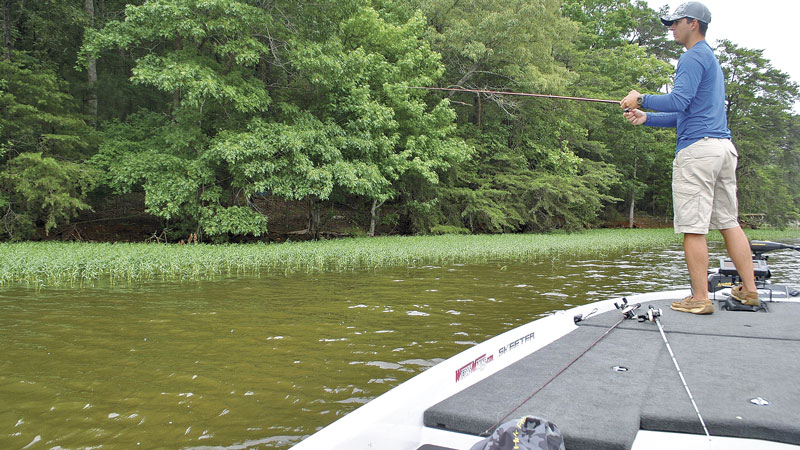
“Those fish that have been in those mats all summer-long are about to pull out and position on the edge,” Hackney said. “They’re just putting on their feed bag for winter. As soon as that water temperature starts to drop, they’re coming out.”
Access and proximity
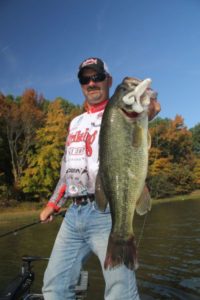
The two-fold advantage, he said, is access and proximity. Big fish that have spent most of the summer tucked way out of reach in their grassy fortresses are venturing into catching range. Best thing about it is, you don’t have burn a lot of time bouncing from creek to creek in search of feeding fish.
Essentially, a fall grass bed is like a creek unto itself. Here, the bass find abundant cover and lots of baitfsh, bream and crawfish.
“Especially in the South, it’s hard to catch those big fish during the hotter months because of the way they’re positioned,” Hackney said. “It’s like they’ve been gone all summer and then, all of a sudden, they just reappear again.
“These fish that set up on the outside edges of the grass are there to eat; they’re not there for any other reason. They’re in an aggressive posture. They’re sitting there looking outward and waiting to ambush something as it comes by.”
Said Kenney: “This time of year, I don’t expect to find them way back in the mat. If they’re in the mat, they’re in the first 10 feet.”
Looking to ambush
As Hackney explains, fall bass with eating on their minds will set up on the edge of grass beds and use the contour features much like they would the shoreline variances. Points are points, and angles are angles, whether they’re made of rock, clay and wood or aquatic vegetation, and they provide bass a place to ambush bait.
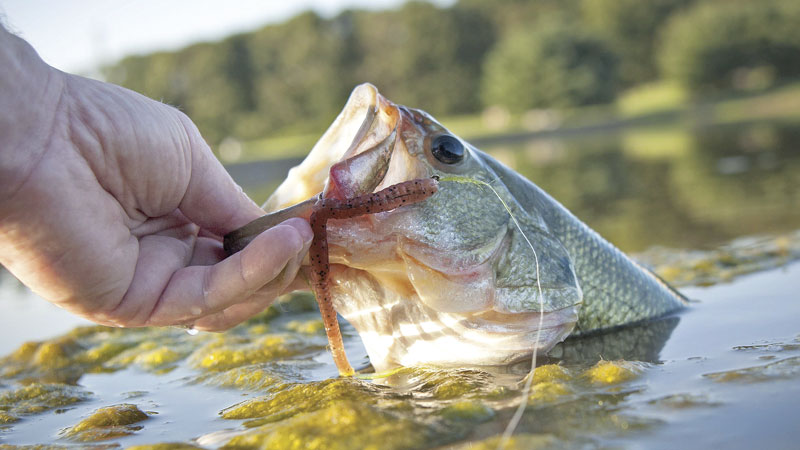
“It makes it easy to fish, because you can usually see those points, turns and drains a lot easier than if you’re fishing underwater stuff,” Hackney said. “You can really learn a lot about the area when the grass is matted up and then when it starts to die back, you’ll know how the place sets up. You’re a lot more efficient.
“It’ll also show you how the grass will grow to the break, it will show you if there’s hard bottom. If there’s a hole in the grass, you know there’s a rock or a stump down there.”
Kenney said the variations are great, but baitfish are still the key.
“If there’s a straight edge for 30 feet, and then all of the sudden, there’s a little point sticking out; that’s usually the key spot,” he said. “But that time of year, it’s all about the bait, and bait doesn’t necessarily relate all the time to stuff like that. So you might also catch them on the straight stretches of grass, too, if that’s where the bait is.”
Active presentations
Hackney and Kenney are both flippers at heart, so they know that grass plus bass always equals some level of opportunity to drop a heavy lure near the salad. It’s usually not an all-day thing, but when the fish are set up right, a quick vertical presentation meets with violent reception.
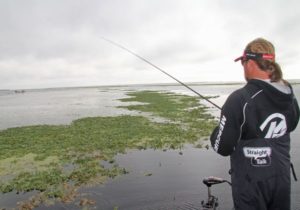
“These fall bites are aggressive,” Hackney said. “When you get around them, they’ll slack the line. On cool mornings, they might be 6 or 7 feet deep, but as the day heats up, they may be as shallow as a foot deep, suspended. And, of course, the shad come up as the water warms up.”
Now, the thing about the fall bite is that bass mean business wherever they may be holding. This is the time for some serious belly-filling, and nibbling just isn’t in the playbook, with the exception being bluebird skies behind a cold front. In stable conditions, expect aggression.
“Those deeper fish will hit the bait on the drop, and they hit is so hard it kind of scares you,” Hackney said. “You’re like ‘What was that?’ because we’re not used to getting bit like that.
“Usually, when we’re fishing in grass, we’re feeling for pressure or little line twitches, but these fish will hit it with a hammer. You don’t have to ‘check’ these fish; they really engulf the bait.”
Baits
This provides good insight for bait choice. For that daybreak to mid-morning bite, you’ll probably do best by flipping jigs or Texas-rigged baits along those grass edges to reach fish holding lower in the water. A heavy bait falling quickly past their face generally triggers those aggressive feeding strikes, even if the fish haven’t yet risen with the warming water.
Hackney uses both presentations with a Strike King Rodent or Rage Tail Menace grub on a 5/0 flipping Hook and a 1-ounce tungsten weight or a 1-ounce Strike King Hack Attack jig toting a Strike King Rage Craw trailer. The jig is his big-fish bait, while Texas-rigged plastics have their place in the plan, too.
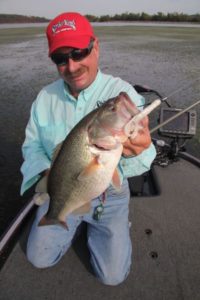
“With that jig’s big profile, you eliminate a lot of smaller bites,” Hackney said. “Normally, you don’t get as many bites on the jig as you would a piece of plastic because it’s an aggressive bait, and sometimes, little fish will shy away from it.
“There are certain times of the year when the big-bait, big-fish theory holds true, and the fall is one of those times. This is when those big fish are biting, so I’d rather target them by giving them something with a bigger profile for an easy meal.”
Of course, given the requisite patience necessary for earning a handful of big bites, some might prefer quantity to quality. No problem; just tie on that Texas rig and drop away. You’ll likely catch more numbers and, by sheer probability, you might even luck into one or two of those giants along the way.
“I can go all day with a handful of bites because I’ve done this so much,” Hackney said. “But when I take my children, I have them fish plastics behind me.”
Take it to ’em
Hackney said that fall is a great time to catch grass fish on spinnerbaits, buzzbaits and topwaters, especially frogs. Fall bass may be focused on shad, but they won’t hesitate to gulp a wayward amphibian, if they can spot it and reach it.
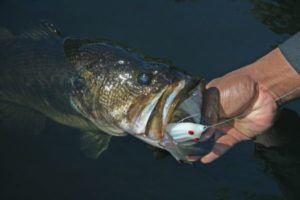
“Hydrilla gets pretty thick, so you’d have to target areas where you have more open holes for the fish to get the frog,” he said. “That hydrilla can be 6 to 8 inches thick, and it’s not that they couldn’t get through there, but it’s hard for them to know the bait’s up there. It’s different with milfoil; they don’t have any trouble blowing right through milfoil.”
Kenney’s also a big fan of topwater frog action, and the bait’s back color is far less important to him than its belly. He’s all about a white belly because it most closely resembles a shad to an upward-looking bass.
“Something else that works pretty good, too, is a white buzz toad,” Kenney said. “With those legs kicking and bubbling, I guarantee you they think it’s a shad that’s got up there on top of the mat, flickering around.”
Favoring the Gambler Cane Toad rigged on a 5/0 Gambler KO hook, Kenney will cast his bait onto a grass mat and slowly work it back to the edge, where he’ll increase his retrieve speed. That allows him to blend the slow, hopping cadence of a hollow-body frog, as well as that classic buzz toad action.
For this presentation, as well as a Chatterbait he also likes to throw around grass edges, Kenney arms himself with tackle sufficient for separating a big fish from its grassy stronghold. His signature series 7-foot-6, medium-heavy Halo Titanium rod with a Bass Pro Shops Johnny Morris 7:1 reel carrying 65-pound braided line.
Get ’em while they’re hot
After his tournament season ends, Hackney’s usually ready to trade the rods for rifles and a bow. However, even when he’s perched in a tree stand, his mind often ponders the fall grass bite.
“A lot of people miss this fall bite because it’s hunting season,” he said. “It’s gotten harder, as I get older, to enjoy this bite because I do a lot of hunting. It’s that time of year when everything is going on, but these fish are really aggressive.”
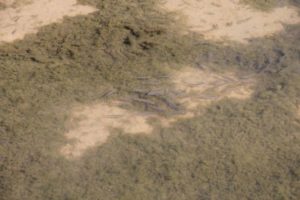
When he’s picking a fall grass spot, Hackney instinctively looks for an isolated mat that’s clearly detached from a larger, adjacent mat. Most anglers automatically equate mass with opportunity, but Hackney said he often finds a gold mine of opportunity in a smaller grass mat.
“I always look for those isolated mats because they’re the ones that everyone overlooks,” he said. “Most people will blow right past a little grass mat and stop on the bigger ones. You’ll catch fish on the big mats, too, but often times, they get picked over pretty good.”
That being said, a major benefit of fall’s abundant options is less boat traffic.
“People are doing other things, so it’s a good time to be fishing, because there’s not a lot of people on the lake as the weather’s turning colder,” Hackney said. “This is a great time of year to catch a big fish.”
Profile, action dictate trailer picks
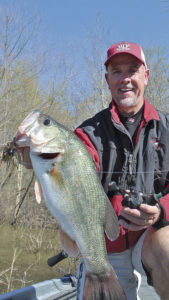
For trailers or Texas-rigged plastics, bass pro Greg Hackney keeps it simple on the color selection. Black/blue or Okeechobee craw gets the call for cloudy days and darker water, while more vivid patterns work best in clear water and brighter conditions.
“If I’m confident that they’re on a bream pattern, I’ll go with gator craw or sexy craw, which has some orange in it,” he said. “If crawfish are the dominant pattern, I’ll stick with the natural colors like green pumpkin, and sometimes, I’ll put a little orange tip on the claws with Dip-n-Dye, because in the fall, if you get around crawfish, they’ll be greenish and have a little orange on the tip.
“Even though a fish will bite a solid-black lure if what they’re feeding on is white, I find you get more bites if you stay as natural as possible. As for those orange tips, I just think that sometimes it’s the little things that make the difference. Will it get you 10 more bites? No, but it might get you two or three, and one of them could be the fish of a lifetime.”
Trailer style generally comes down to two criteria: action and profile. When fish are hot to chew in stable, fall weather, a slender-body trailer with a lot of action in the appendages will fall fast to entice those aggressive, feeding strikes. If the bait happens to make it to the bottom without getting hit, the wiggly appearance might coax a late taker.
Conversely, if a fall cold spell has the fish a little slow on the trigger, you might want to ease back on the fall rate with a bulky, chunk-style trailer that has more mass than action. In this scenario, making a bait easier to catch is more important than making it visually enticing.
